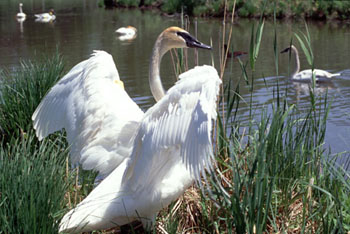|

Trumpeter Swan Appearance: This species is the largest swan in the world. It is white with a long neck it stretches straight
out in front while in flight.
Females typically weigh up to 25 lbs, and males up to 30 lbs
There are few noticeable differences between the sexes, making it difficult to distinguish males from females without
an internal examination
The wingspan of an adult Trumpeter can reach almost 2.5 meters
Food: Aquatic plants and insects, snails. Adults eat up to 9 kg each per day. Their long necks and powerful bills allow
them to reach down and pull up roots and stems other birds can't reach.
Breeding: Trumpeter swans usually mate for life. Their big, bulky nests are mounds of reeds, rushes, roots and grasses
lined with fresh swan's down. They're often built on top of beaver lodges, muskrat houses or small islands.
In mid-May, the female lays five or six eggs which she incubates until they hatch about 32 days later. The cygnets stay
in the nest only about 24 hours until they can keep themselves warm. They have very little food reserve and must quickly start
feeding.
Adult swans are flightless for about a month when they moult in the summer. As a result, male and female trumpeters moult
at different times so one adult in a breeding pair will be able to fly while the other stays with the cygnets.
Lifespan: Up to 35 years in captivity, 12 years in the wild.
Status: Trumpeters are the rarest swan in the world. They used to be abundant in North America but by the early 1900s,
they were nearly extinct. Huge numbers had been shot for their down, feathers or meat. Increasing settlement disturbed suitable
nesting areas.
Risk factors: The major limiting factor affecting Alberta trumpeters is the size of their wintering area, a 15-km section
of the Snake River in eastern Idaho. They must compete for food in this small area with other migratory trumpeters and birds
that live there all year. As a result, some birds may be in poor condition by spring. They lack energy for migration, egg
laying and incubation.
Management and Outlook: Overall, trumpeter swans in North America are a conservation success story. Their outlook is bright.
http://www.wyemarsh.com/swan_reintro.html is a site describing a re-introduction program, which is around my area.
An international restoration program began in the 1930s and trumpeter swans have responded well. They are still considered
vulnerable in Canada, with about 550 swans nesting in Yukon, northern B.C., southwestern N.W.T. and the Grande Prairie/Peace
River region of Alberta.
Biologists in the U.S. are trying to relocate wintering birds from the Snake River to other suitable habitats in Wyoming,
Utah and southern Idaho.
Since 1987, Canadian biologists have attempted with some success to re-introduce trumpeters to their former breeding area
in Elk Island National Park. They take family groups from around Grande Prairie, then mark and release them in the park. The
adults will return to Grande Prairie the following year while the young will return to the park, where they learned to fly.
Trumpeters breed well in captivity. Young from a small flock at Camrose Alberta are being fostered back to the wild.
All swans in Canada are protected. Killing them is illegal.
What Can I Do: The majority of released Trumpeter Swans in Ontario are leg-banded with a metal band and identified with
large plastic yellow wing-tags with a three-digit number on it.(seen in photo) Tracking the health and movements of the swans
is very important to the reintroduction program, and anyone seeing a Trumpeter Swan should report it to the Wye Marsh by phone
(705) 526-7809 or email swans@wyemarsh.com
Personally, I do this every time I spot a Trumpeter Swan. I recall one very very cold day in February 12 Trumpeters sat
on the ice, all tucked in trying to stay warm, while I nearly froze trying to read wing-tag numbers. Its a small thing, but
each of us can make a difference.
Visit Wye Marsh Wildlife Centre
Back to Birding with Frank
|



